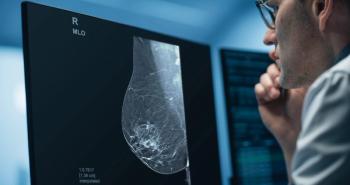
Emerging options compete with mammography
It is a safe bet that conventional mammography will give way to 3D imaging and other advanced technologies in the not-too-distant future. The gamble lies in picking which technology will emerge the clear winner as the primary screening tool for breast cancer: digital breast tomosynthesis or dedicated breast CT.
It is a safe bet that conventional mammography will give way to 3D imaging and other advanced technologies in the not-too-distant future. The gamble lies in picking which technology will emerge the clear winner as the primary screening tool for breast cancer: digital breast tomosynthesis or dedicated breast CT.
Digital breast tomosynthesis is based on modifications to full-field digital mammography systems. Scanning of the compressed breast is done in an arc to capture multiple images. After acquisition, the data are reconstructed into parallel slices.
Joseph Lo, Ph.D., of Duke University Medical Center highlighted some of the benefits of DBT in Medical Physics (2008;34[2]: 409-411): high resolution in the x-y plane parallel to the compression paddle; 1-mm resolution in the z plane; tomosynthesis enhancement of existing FFDM technology; and patient throughput similar to conventional mammography.
"Tomosynthesis delivers practical and effective 3D images. We may use slightly less compression to achieve dose reduction, positioning, and immobilization while avoiding pain," Lo said.
Recent studies support Lo's argument in favor of breast tomosythesis. Two separate groups out of Massachusetts General Hospital are currently working with breast tomosynthesis. One has scanned more than 2000 women with a clinical prototype unit by GE Healthcare and found that improved visualization led to a 37% reduction in the callback rate.
A multicenter study on a prototype scanner by Hologic of Bedford, MA, found that tomosynthesis boosts radiologists' cancer detection rate compared with FFDM alone. Tomosynthesis turned in a sensitivity of 76.2% versus 65.5% for FFDM alone and a specificity of 89.2% versus 84.1% for FFDM.
But the optimal role for tomosynthesis in a screening setting needs to be firmed up, according to Dr. David Gur and colleagues at the University of Pittsburgh and Magee-Womens Hospital.
In their pilot observer study, readers perceived tomosynthesis images to be significantly better than the FFDM ones. Unlike the earlier studies, they noted a higher rather than lower recall rate, however. Gur's group concluded that implementing tomosynthesis into a clinical setting would require significant personnel training (AJR 2008;190[4]:865-869).
For breast CT, each breast is scanned individually in the pendant position with the patient prone on the scanning table. The field-of-view has a diameter of 21 cm. Five hundred conebeam projection images are acquired at 360° around the patient's breast in 16.6 seconds.
Initial clinical experience with breast CT has shown it is equal to screen-film mammography for overall lesion visualization and significantly better for pinpointing masses (Radiology 2008;246[3]: 725-733).
Andrew Karellas, Ph.D., from the University of Massachusetts Medical School in Worcester offered his take on why breast CT will best DBT as a screening tool (Med Phys 2008;34(2):409-411). He cited breast CT's strengths: delivery of isotropic spatial resolution for true 3D imaging; lower susceptibility to image reconstruction artifacts; no compression requirement; patient imaging in a prone position; and increased suitability for imaging dense breasts and implants.
"Given the choice between limited tomography with breast compression offered by tomosynthesis and full tomography with 3D imaging, dedicated breast CT offers a more powerful alternative," Karellas said.
John Boone, Ph.D., and Dr. Karen Lindfors at the University of California, Davis are at the forefront of breast CT development. To date, their group has performed 150 breast CT scans.
In a recent article in Radiology, the group noted that in its study, CT was equal to mammography for visualization of breast lesions. Breast CT was also better than mammography for visualization of masses, although mammography outperformed CT for the depiction of microcalcifications (2008:246[3]: 725-733).
"The most obvious advantage of breast CT over tomosynthesis is that one scan provides the high-resolution 3D data set, which allows simultaneous and coregistered viewing of all three orthogonal planes," Boone said.
Newsletter
Stay at the forefront of radiology with the Diagnostic Imaging newsletter, delivering the latest news, clinical insights, and imaging advancements for today’s radiologists.



























